In the world of prepping and survival, where every detail counts and every tool can make a critical difference, a tactical flashlight is more than just a source of light—it’s a strategic asset. Designed for robustness and versatility, tactical flashlights offer far more than their standard counterparts, proving indispensable in high-stress situations where reliability and performance are paramount.
Key Takeaways
- Tactical flashlights are designed for high performance, durability, and versatility.
- Key features include high lumens, durable construction, and multiple modes for various scenarios.
- Tactical flashlights are useful for military, law enforcement, emergency situations, outdoor activities, and personal safety.
- Proper maintenance and the right accessories can extend the lifespan and functionality of your tactical flashlight.
This guide will walk you through everything you need to know about tactical flashlights, from their key features and uses to how to choose the best one for you.
What is a Tactical Flashlight?
A tactical flashlight is a high-performance flashlight designed for use in demanding situations, often by military personnel, law enforcement, and outdoor enthusiasts. Unlike regular flashlights, tactical flashlights are built to withstand tough conditions and offer features like high brightness and multiple modes for various scenarios. They are usually compact, easy to carry, and made from durable materials like aluminum. Tactical flashlights are often used for self-defense, as their intense light can temporarily blind an attacker.
Here’s what makes tactical flashlight suitable for demanding situations:
Durability and Build Quality: Tactical flashlights are crafted from robust, lightweight materials like aircraft-grade aluminum, designed to endure harsh conditions. Their durability extends beyond just physical strength; these flashlights are also built to resist water and impact. With an IPX rating for water resistance, they can handle rain and splashes, while their impact-resistant design ensures they withstand drops and rough handling.
Light Output and Lumens: These flashlights deliver impressive brightness, typically exceeding 500 lumens. This level of illumination provides clear visibility and the added capability to disorient an opponent when necessary.
Modes and Functions: Tactical flashlights offer a range of settings, including high, medium, low, and strobe modes. The strobe function can be used to confuse attackers, and some models feature an SOS signal for emergency situations.
Battery Life and Types: They are often powered by rechargeable lithium-ion batteries but can also use disposable types like AA or CR123A. The long battery life is crucial for extended use in survival scenarios.
Parts of a Tactical Flashlight
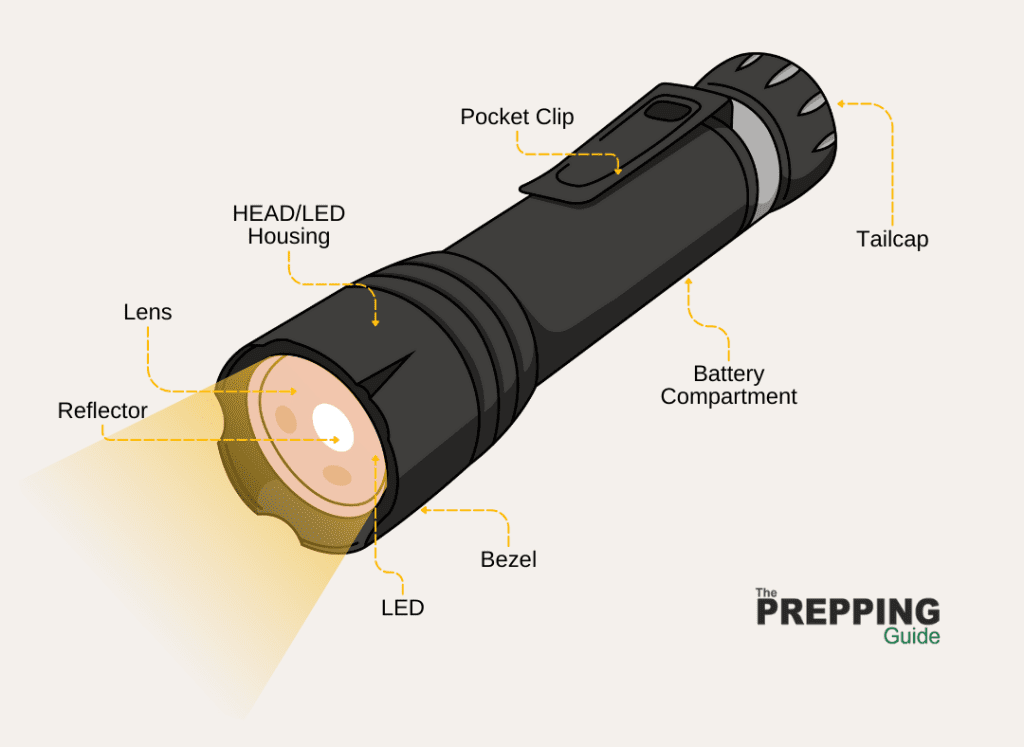
A tactical flashlight is more than just a beam of light; it’s a carefully engineered tool designed for reliability and performance. Understanding its parts can help you appreciate how it works and choose the best one for your needs. Here’s a look at the key components that make a tactical flashlight so effective:
1. Body
The body is the main structure of the flashlight. Typically made from rugged materials like aircraft-grade aluminum, it’s built to withstand tough conditions. Its design often includes textured grips to ensure you can hold onto it securely, even in slippery or high-stress situations.
2. Lens
The lens is the clear part at the front of the flashlight through which the light is emitted. It’s usually made of toughened glass or polycarbonate to resist scratches and impacts. The lens focuses and directs the light beam, making sure it reaches your target with precision.
3. Bulb or LED
Modern tactical flashlights use LEDs (Light Emitting Diodes) instead of traditional bulbs. LEDs are brighter, more energy-efficient, and have a longer lifespan. The LED is responsible for producing the intense light you rely on for visibility and tactical advantage.
4. Reflector
Behind the lens and LED, the reflector is a crucial part of the flashlight. It’s often a concave surface that helps shape and focus the light beam, creating a concentrated spot or a wider flood, depending on the design. The quality of the reflector can significantly affect the beam’s effectiveness.
5. Switch
The switch controls the flashlight’s various modes. It can be located at the back, side, or on the tail cap of the flashlight. Tactical flashlights often feature tactical switches that allow for quick, easy operation—essential when you need to switch modes rapidly in critical situations.
6. Battery Compartment
This is where you insert the batteries. Many tactical flashlights use rechargeable lithium-ion batteries, but some still use disposable batteries like AA or CR123A. The battery compartment is designed to be secure and often features an O-ring seal to keep moisture out.
7. Tail Cap
The tail cap is the end piece of the flashlight that often houses the switch and battery compartment. In tactical models, it may also have a strike bezel, which can be used as a self-defense tool if needed. The tail cap can also be designed for quick battery changes.
8. Heat Sink
To prevent overheating during prolonged use, many tactical flashlights include a heat sink. This component helps dissipate heat away from the LED, ensuring the flashlight remains cool and maintains optimal performance.
Uses of Tactical Flashlights
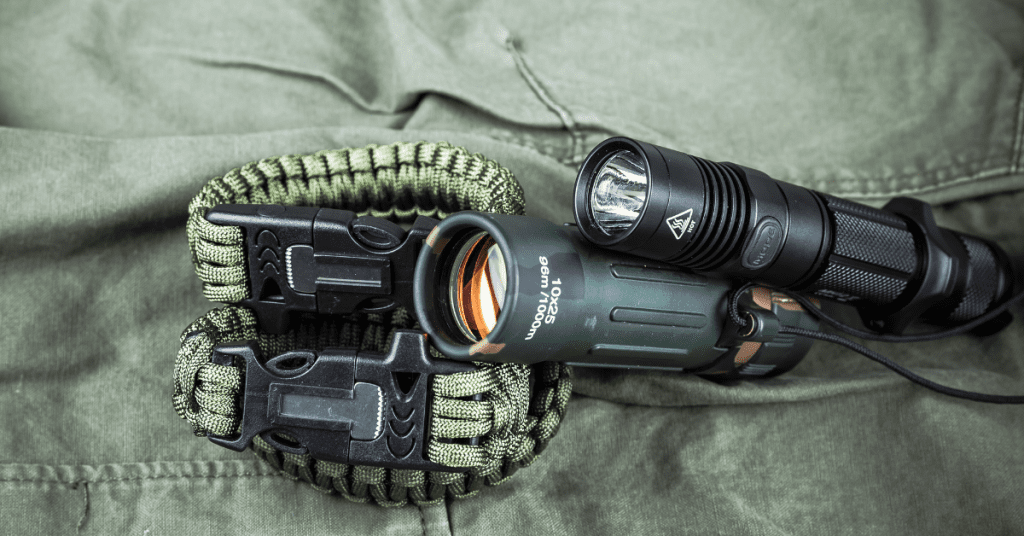
Tactical flashlights are versatile tools that serve a variety of purposes, from professional use in demanding fields to everyday personal safety. Below are the key applications where tactical flashlights prove invaluable.
Military, Law Enforcement, and Self-Defense
Tactical flashlights are essential for military and law enforcement personnel, providing powerful illumination during nighttime operations and offering a strategic advantage with features like strobe mode to disorient suspects. These flashlights are also useful for self-defense, as their intense light can temporarily blind or confuse an attacker, and many models feature strike bezels that can be used as improvised weapons. The durability and reliability of tactical flashlights make them indispensable in high-stress situations.
Emergency, Survival, and Harsh Environments
In emergencies, tactical flashlights are crucial for signaling for help and illuminating large areas during power outages or natural disasters. Their rugged construction allows them to withstand harsh conditions like heavy rain or extreme temperatures, ensuring they remain functional when needed most. The reliability of tactical flashlights in tough environments makes them a valuable tool for survival and emergency preparedness.
Outdoor Activities and Enhanced Visibility
Tactical flashlights are popular among outdoor enthusiasts, such as campers, hikers, and hunters, due to their high lumen output, which effectively lights up trails, campsites, and remote areas. The enhanced visibility provided by these flashlights is essential for safe navigation in low-light conditions, reducing the risk of accidents or encountering hazards. Their water and impact resistance further ensure dependable performance in various outdoor settings.
Everyday Carry (EDC) and Personal Safety
For everyday carry, tactical flashlights offer a practical solution for personal safety. Their compact size allows for easy portability, whether in a pocket, purse, or on a keychain. Beyond providing light, these flashlights can illuminate dark paths, deter potential threats, and serve as a self-defense tool if necessary. The versatility and convenience of tactical flashlights make them a valuable addition to any EDC setup.
How to Choose the Right Tactical Flashlight
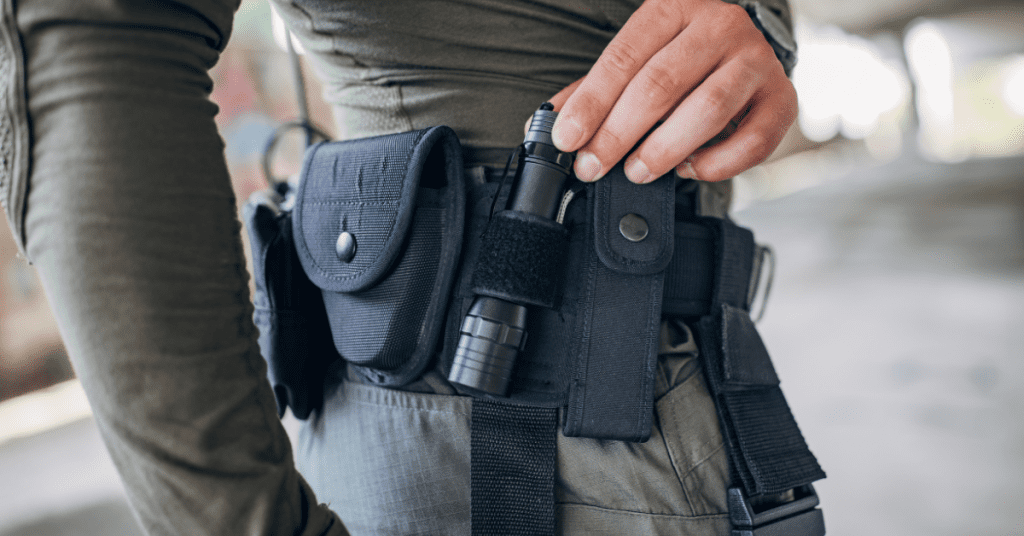
When selecting a tactical flashlight, consider the size and weight, as these will affect how easily you can carry and use it. The brightness, measured in lumens, is crucial depending on your intended use—higher lumens for tactical situations and lower for everyday tasks.
Battery life and type are also important, with rechargeable batteries offering convenience and cost savings, while disposable batteries might be more suitable for long-term storage or emergency use. Durability and build quality are essential, especially if you expect the flashlight to withstand rough handling or extreme conditions. Finally, consider your budget, as prices can vary significantly based on features and brand reputation.
Maintenance and Care for Tactical Flashlights
To keep your tactical flashlight reliable, follow these maintenance tips:
- Cleaning and Upkeep: Regularly clean the flashlight to remove dirt and debris. Use a soft, damp cloth for the exterior and a dry cloth for the lens. Avoid harsh chemicals that could damage the flashlight.
- Battery Management and Replacement: Use the recommended battery type and check for leakage or corrosion regularly. Replace batteries promptly when they weaken to ensure the flashlight is always ready for use.
When it’s time to replace the batteries in your tactical flashlight, consider the following factors to ensure optimal performance and reliability:
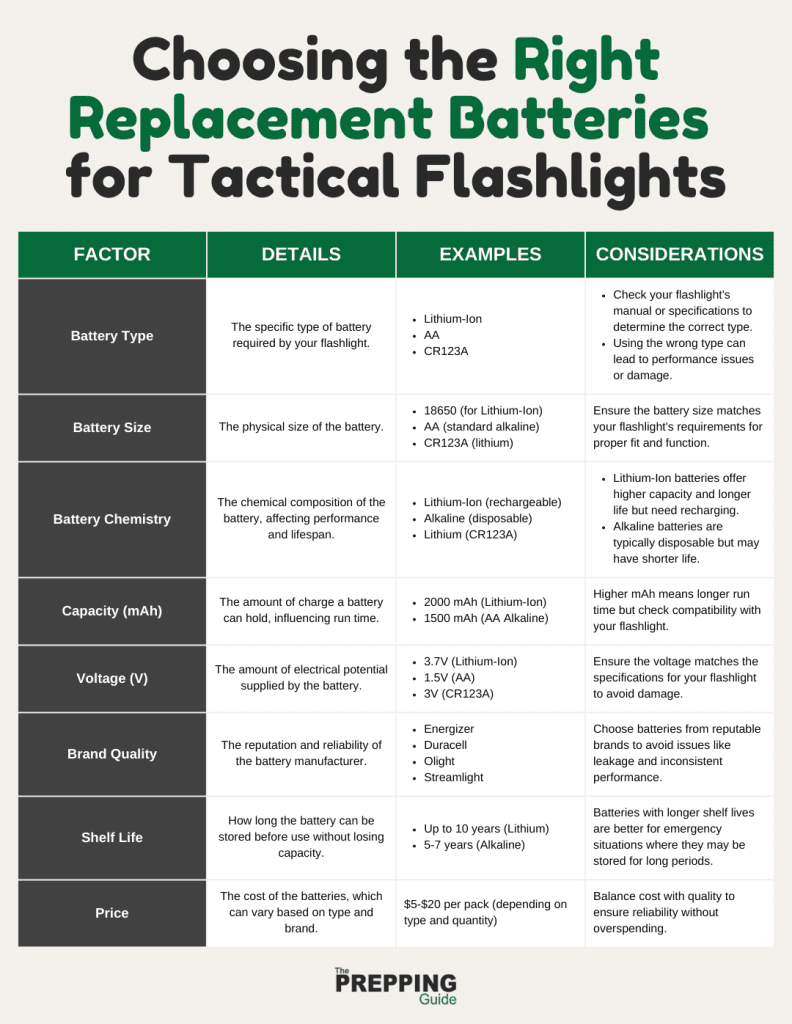
Storage Tips to Prolong Lifespan
When not in use, store your tactical flashlight in a cool, dry place to prevent moisture damage. If you’re storing it for an extended period, remove the batteries to avoid potential leakage. Keeping the flashlight in a protective case or holster can also help prevent scratches and damage.
Tactical Flashlight Accessories
To enhance the functionality and convenience of your tactical flashlight, consider adding some useful accessories. Below are a few options that can make your flashlight even more versatile.
Mounts and Clips
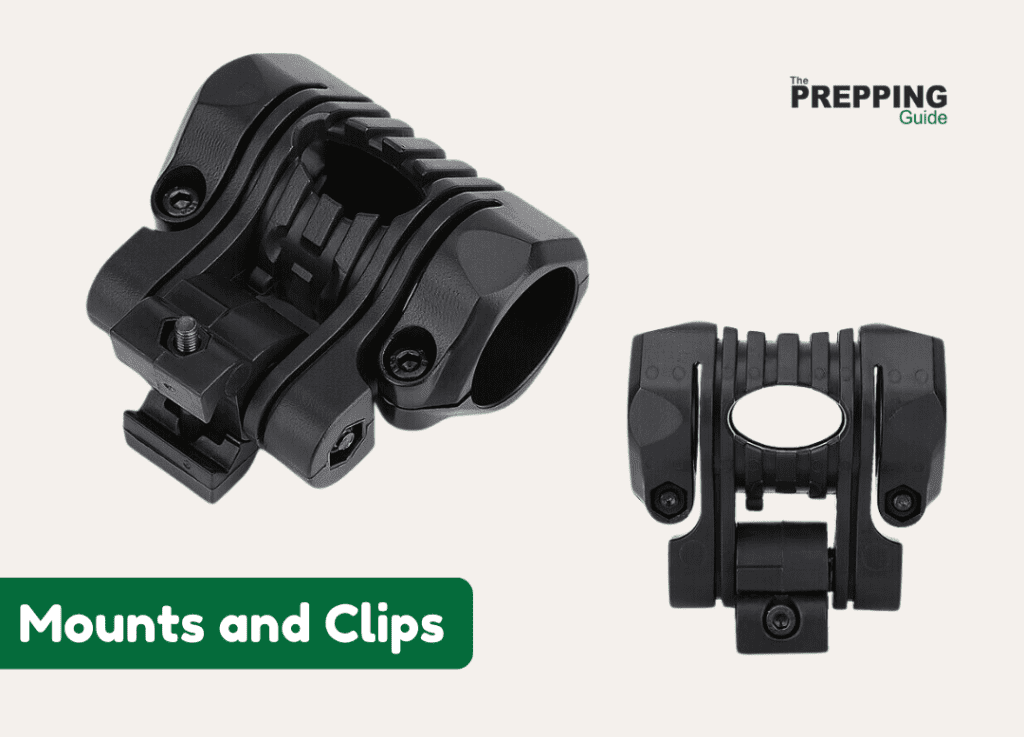
Mounts and clips are essential accessories that allow you to attach your tactical flashlight to various surfaces, such as helmets, belts, or firearms. These accessories provide hands-free operation, making them ideal for tactical, hunting, or work-related tasks.
Filters and Diffusers
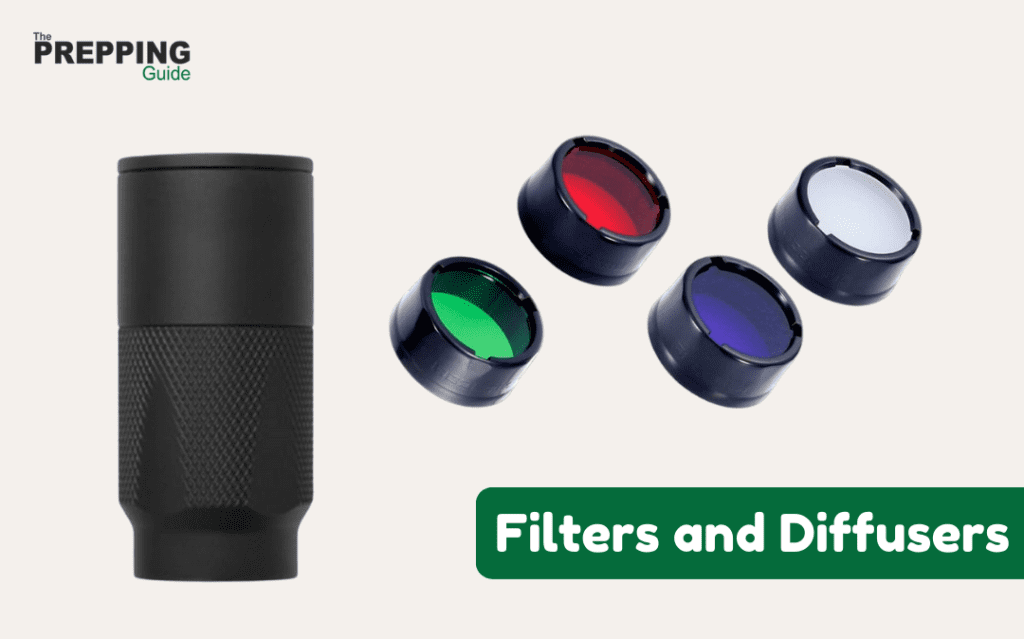
Filters and diffusers modify the light output of your tactical flashlight, allowing you to adapt to different situations. For example, red filters help preserve night vision, while diffusers spread the light over a wider area for general illumination. These accessories can be quickly attached or removed, providing flexibility in various environments.
Holsters and Cases
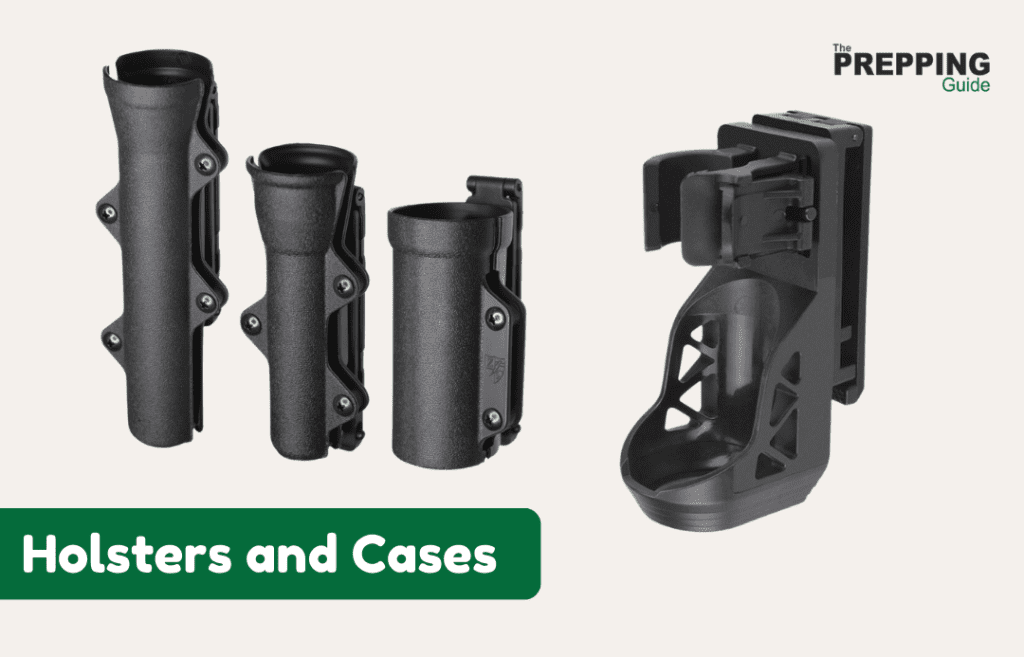
Holsters and cases provide a convenient way to carry and protect your tactical flashlight when it’s not in use. A holster allows easy access to the flashlight on your belt or gear, while a case offers more comprehensive protection during transport. Both accessories help prevent damage and make your flashlight readily accessible when needed.
Discover a wide range of top-quality tactical gear. Explore our tactical gear collection now and ensure you’re ready for any situation.
Conclusion: Lighting the Way Forward
Tactical flashlights are more than just tools; they are essential companions in both everyday life and challenging situations. By understanding their features, applications, and proper care, you can ensure your flashlight remains reliable and effective whenever you need it. Whether you’re selecting the right model or choosing accessories, remember that a well-maintained tactical flashlight can be a lifesaver in critical moments.
FAQs
What is the difference between a tactical flashlight and a regular flashlight?
A tactical flashlight is designed for high-performance use, often in demanding or emergency situations, whereas a regular flashlight is generally intended for everyday household tasks. Tactical flashlights typically have a higher lumen output, more durable construction, and additional features like strobe modes or strike bezels for self-defense. They are also built to withstand harsh conditions, making them more reliable in critical scenarios.
Can a tactical flashlight be used underwater?
Many tactical flashlights are water-resistant and can be used in wet conditions, but not all are designed for full submersion underwater. The level of water resistance is usually indicated by an IPX rating. For example, an IPX8 rating means the flashlight can be submerged in water for extended periods, making it suitable for underwater use. Always check the specific rating of your flashlight to ensure it meets your needs.
How long do tactical flashlights typically last?
The lifespan of a tactical flashlight depends on the build quality, usage, and how well it’s maintained. A well-made tactical flashlight can last for several years, with the LED bulb itself often rated for tens of thousands of hours. Battery life varies depending on the type of battery used and the flashlight’s brightness settings, with higher lumens typically consuming more power.
Are there rechargeable tactical flashlights available?
Yes, many tactical flashlights come with rechargeable batteries, offering the convenience of recharging via USB or specialized charging stations. Rechargeable models are popular because they reduce the need for frequent battery replacements, making them more cost-effective and environmentally friendly. These flashlights are ideal for users who need reliable, long-lasting power without the hassle of carrying spare batteries.
What is the best way to test a tactical flashlight’s durability?
To test a tactical flashlight’s durability, you can perform drop tests from various heights to see if it continues to function properly. Additionally, testing the flashlight’s water resistance by submerging it according to its IPX rating can help ensure it will perform in wet conditions. Checking the flashlight’s performance in different temperatures, from extreme cold to heat, will also give you an idea of its reliability in harsh environments.

Thanks for the descriptions of the various hold positions. Guess the “Harris” works better for me, though I’ve got some smaller flashlights that could work with the Surefire. Need to practice that one.
As for the list of other uses, #4 seems to be a hold-over from much earlier times. How many modern tactical flashlights still use an incandescent bulb? All of mine are Cree LEDs.
No problem Mic. The surefire still doesn’t work for me as I can never get a small enough flashlight that I am actually happy with. I think I’d have to use a penlight.
And I am glad you pointed that out. My old Maglite uses a bulb, and I know there’s a lot of others that use the old school heavy wielding flashlights. But you’re right, it seems as time goes on LED will phase out incandescent flashlights, that’s for sure.
Exactly – it’s Cree xml-t6 powered or its junk no matter what the price. 18650 lithium battery is 3.7v perfect to power xml-t6 LED. Alkaline batteries are primitive and ancient today. Solar chargers for 3.7v lithium are plentiful.
ok, this is an old article.
Besides the very nature of a flashlight is “tactical”
so…redundant..
My dad had an angled tactical flashlight and I was curious how the “red filter” worked? Does it really aid in reading maps? Does it have other uses? These newer tactical flashlights are wonderful additions to my bag. Thank you for sharing your knowledge and practical uses on this subject! ^Eric
Thanks for sharing your knowledge on flashlights. A little know how goes a long way.
The military uses red light headlamps as well as red handheld flashlights. Although they can vary by design and specific features, the fundamental focus on a red light is the same. There are three reasons why the military uses red light for their flashlights: to preserve and improve night vision, to reduce a person’s light profile, and to send out signals.
Thanks so much for sharing! Your article is helpful and very interesting for me.
there are some ways to use a tactical flashlight for self-defense: Give SOS Signal, Stun the attacker, Strike the attacker, etc.
How do you turn a tactical flashlight off